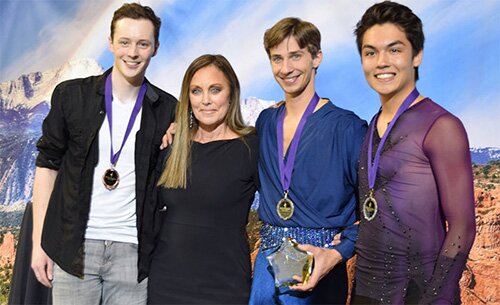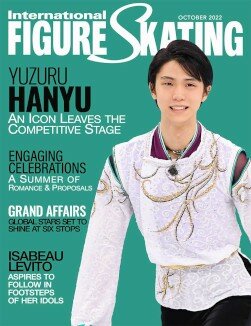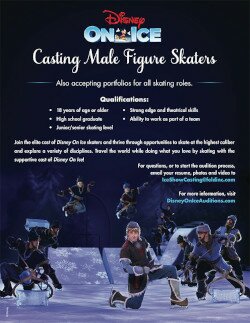

The Broadmoor Open, an annual competition that takes place each June in Colorado Springs, Colorado, has attracted numerous competitors from across the United States over the past two decades. Known for its unique jumping competition the past four seasons (Aerial Figure Skating Challenge), a new event was added to the roster this year.
The Peggy Fleming Trophy, a competition that focuses on artistry, performance, choreography, and skating skills is the brainchild of 1968 Olympic champion, Peggy Fleming, and former World and Olympic judge, Gale Tanger.
Tanger was looking to create a special event with Fleming for the Broadmoor Open’s 20th anniversary in 2017, but due to scheduling conflicts they were unable to put something together in time.
Fleming, a longtime member of the Broadmoor Figure Skating Club, attended last year’s competition and one afternoon she and Tanger met with Fabio Bianchetti, the chair of the International Skating Union (ISU) Single and Pairs Skating Committee. During that meeting, Bianchetti mentioned the ISU was considering changing the structure of competitions after the 2022 Winter Olympic Games. “He said that instead of having a short program or a short dance they would have an artistic program and a technical program,” Tanger said. “The programs would be of equal length, with each about three and a half minutes. As he was explaining this, Peggy and I looked at each other and said, ‘There it is.’
“Peggy has some really strong feelings about artistry. She has watched the sport evolve away from the artistic side and as we all know, that was her trademark. So we decided to pursue the concept of an artistic program.”
Tanger said it took them almost a year to create and nail down the rules and element requirements for the competition. “We know that if this is going to be looked at as an Olympic sport and be approved as an Olympic sport, programs also need to have technical elements,” Tanger explained.
Together, she and Fleming ultimately settled on a program with eight required technical elements: three jumps, three spins, a step sequence and a “signature move.”
“With the signature move we wanted to see if we could regain some of those iconic skating moves or if the skaters would come up something new that we had never thought of. We really wanted to encourage the skaters to bring a lot of creativity and originality back to the sport (through this event),” said Tanger.
While no specific jumps, spins, or steps were defined specific guidelines for this competition were set. For the jumps: one toe and one edge jump — both with at least two rotations — were required. The third had to be a combination or creative jump with an unlimited number of rotations. Both double and triple jumps were valued the same by the technical panel but no jump elements were reviewed with respect to the takeoff edge or under-rotation.
For the spins, one had to be a combination, which included all three basic positions with a change of foot; one in a singular position, and the third, a creative spin — each with a minimum of six rotations. The spins were not given a level and no base value was applied.
Seven difficult turns were required for the step sequence — as defined by the current ISU rules — but again, the technical panel did not apply levels. “We wanted everyone to have a comfort level of knowing they could be successful,” Tanger said. “Then there is the trade-off: how do you balance the element with the performance of the program? The dynamic of a performance is often athletic, but given an option a skater may take it a different way and say that you can’t do that entry or transitional movement if you set up for a triple or a quad jump. However, maybe they can do it well with a double and embellish it even further with arms or something that gives it a more explosive look.”
It was decided to open the competition to skaters at both the junior and senior levels and to have a mixed event, with men and ladies competing against each other. In total, 27 skaters participated in this inaugural event.
Timothy Dolensky of the Atlanta Figure Skating Club won the competition with a score of 109.04. He was the only competitor to receive a standing ovation. Camden Pulkinen of the Broadmoor Skating Club (100.14 points) and Jordan Moeller of the Northern Ice Skating Club (97.50 points) placed second and third, respectively.
Dolensky performed a powerful and emotional program set to Dan Stevens “Evermore” from the movie “Beauty and the Beast.”
“I definitely knew what I was going to be skating to right from the very beginning. This song was perfect in every way for this event,” said Dolensky who collaborated with choreographer, Daniil Barantsev, on the program.
Dolensky’s routine included a triple flip, a triple loop, and a double axel-half loop-triple Salchow. While all his spins were solid, he finished the routine with a dizzying headless spin. “I thought my performance today was great. It was so much fun to skate that program in such a big arena,” Dolensky said. “When I first heard about the event I just knew it was something I wanted to be part of. This seemed like an event that would exercise everyone’s creativity and I think that is something that our sport needs a little bit more of right now.”
Pulkinen, who was originally on the waitlist for the event, performed a subtle yet moving program to Astor Piazzolla’s “Oblivion.” A shortened version of the routine will serve as his competitive short program this season. “I had nothing really prepared when I found out I was actually going to get to skate, so I just decided to do a longer version of my short,” Pulkinen said. “The actual program was choreographed by Stéphane Lambiel, but there obviously was no time to go and consult with him, so I talked to one of my other choreographers, Drew Meekins.”
Though Meekins assisted, Pulkinen made most of the necessary changes to the program, figuring out how to link the elements himself. “This was my first attempt at not just choreography, but linking elements together in a program,” he said. “It was a learning experience and it showed me that I could perform something I created myself and have it go over pretty well.”
Although he included less technically challenging elements than are in his actual short program, Pulkinen felt that it was a great opportunity for him to focus on presentation and to perform the routine in a competitive setting. “I really took this opportunity to step into a new light as a performer and try to personify myself as the ‘tango-seducer,’ which is the character I am going for in my program.”
Moeller was not only a competitor, but also served as a choreographer for two other skaters, Courtney Hicks and Thomas Schwappach, who finished sixth and 18th, respectively.
For his own program, set to an Albinoni “Adagio,” Moeller turned to Anna Matuszewski, one of the backup dancers for U.S. rapper Mackelmore, for assistance. “She wanted to create a story that was part on ice and part off ice, which was basically about having love once, losing it and the sadness and emotions that come afterward,” Moeller explained. “It was a small piece that we filmed both on and off the ice. It is a really cool piece and I thought it would be fun to perform it at this new event.”
Moeller, who considers himself more of an artistic skater, said he was excited when the Peggy Fleming Trophy was added to the Broadmoor Open line-up. “We have had other events come out, such as the Aerial Challenge, which is a lot of fun, but it is solely jump-based. The fact that someone was trying to put together an event that was solely focused on the artistic side of the sport was really cool and I really wanted to be part of that.”
The programs Moeller created for Hicks and Schwappach were his first foray into choreography for someone other than himself. “I hadn’t really done that before and just being able to see the work we put it and have something come to life was a great experience,” he said. “They got some really good feedback on the programs too, which was really cool for me.”
While many of the skaters in the event were current or former Team USA members, including Dolensky, Hicks, Pulkinen, Moeller, Livvy Shilling, Emily Chan, Andrew Torgashev and Hanna Harrell, the unique nature of the event attracted many other, lesser-known skaters.
One such competitor was Morgan Sewell of the North Atlantic Figure Skating Club, who put a lot of people on notice by finishing seventh with a score of 92.78. Prior to the Peggy Fleming Trophy, she had only competed a handful of times at the collegiate level starting with the 2015-2016 season. Sewell had some success at the lower levels, competing at the U.S. Championships at the juvenile, intermediate and novice levels, but as the technical demands increased she found herself dealing with constant nagging injuries, which led to her ultimately leaving the competitive arena.
Sewell choreographed and performed an interesting and moving program to “The Bear” by Howard Blake. “The music is actually from the soundtrack to the short children’s film ‘The Bear.’ I used to watch the film on repeat when I was a little girl,” she explained. “Matthew Lind at Colonial Figure Skating Club is responsible for sparking my interest in choreography and I have really fallen in love with the creativity and artistry that skating offers. When I found out this competition was one that focused on the artistry of the sport, I knew I had to enter and showcase what I know best.”
She said she thoroughly enjoyed the experience and hopes the ISU decides to follow through on its proposed rule changes. “There are some skaters that are athletic and some who are artistic — and then there are some that have the whole package,” Sewell said. “I think that the more opportunities we have to showcase what we are good at and love to do most, the more popular this sport will become.”
Her sentiment was echoed by many of the other competitors, including Hicks. “I think it will be really good for skating as a whole just to bring back that performance aspect and make it the focus of one of our programs. Skating has been pushed technically so much lately, which is really good and exciting, but I feel like we are losing some of that performance aspect. An event like this one would really help to bring that back.”
Dolensky agreed. “In this day and age when shows such as “Dancing with the Stars,” “So You Think You Can Dance,” and “World of Dance” are so popular, an event like this, I think, is on the same level, as it really allows the skaters to connect with the audience. The fact that we are doing it on ice just makes it that much more interesting. It can only help our sport.”
While the future of figure skating competition structure remains uncertain, the success of the inaugural Peggy Fleming Trophy is not in question. “With this event we wanted the audience to see the skaters’ individual personalities out on the ice,” said Tanger. “In our event, I saw more personalities of real people out there on the ice than I have in a long time. When I was talking to the skaters afterward I didn’t feel like I was meeting them for the first time; I felt like I had already met them out there on the ice.”
Tanger said one of her highlights was that the arena continued to fill up as the event progressed and most, if not all, of the audience members stayed to watch the entire competition. “We were so nervous about the event, but when we got here and saw all the skaters we realized our concept was coming to life,” she said.
“We are moving forward and will be back next year. We hope to make the rules a bit clearer and then see what the ISU thinks of the event, and if we are on the right track.”
(This article was originally published in the IFS October 2018 issue).





